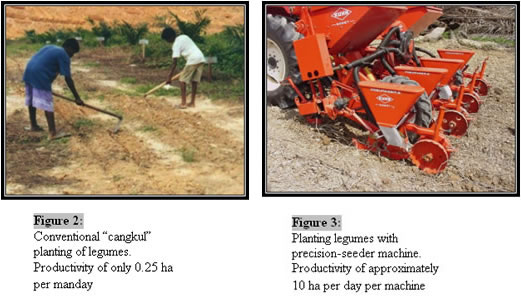Establishment: Legume Planting
Besides protecting exposed soils (Figure 1) from risks of run-off and soil erosion, legumes play an important role in soil conservation in our humid tropics as exposed tropical soils weather rapidly, the soil structure deteriorates, the organic matter content decreases and nutrients are lost through leaching (Corley et al). Therefore, legumes are planted as soon as land clearing and preparation is completed to cover up the bare ground quickly. In addition, legumes also play a role in weed management (Chung, 1997) by smothering out the weeds.
In addition, legume species planted in oil palm areas are able to produce large amounts of organic matter as well as fix large quantities of atmospheric nitrogen. The total biomass of conventional legumes (P. phaseoloides and C. caeruleum) at the end of the third year was 5.9 tons/ha and with newer species of legumes i.e. Mucuna bracteata (Figure 8), total biomass of 17.2 tons and 12.1 tons on flat and terraced land respectively, can be obtained (Chee and Chung, 1998). Other beneficial effects of legumes have been reported by Gray and Hew (1968) and Broughton (1977).
Planting of legumes has evolved from the conventional “cangkul” method to the more modern “precision-seeder” (Figures 2 and 3).

Prior to sowing of the legume seeds, ground preparation such as ploughing of legume beds with a tractor drawn disc-plough and harrowing is carried out (Figures 4 and 5)
. 

Legume establishment is expedited with applications of rock phosphate and ground magnesium limestones (Figures 6 and 7).



